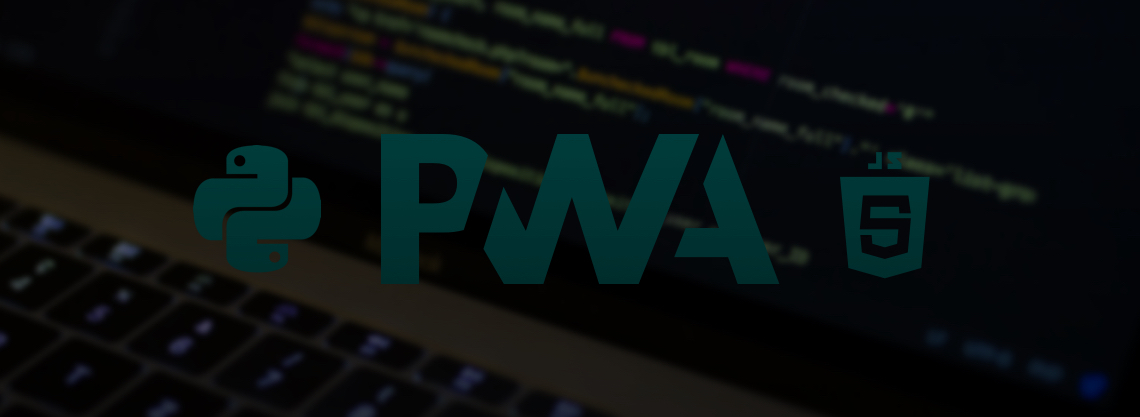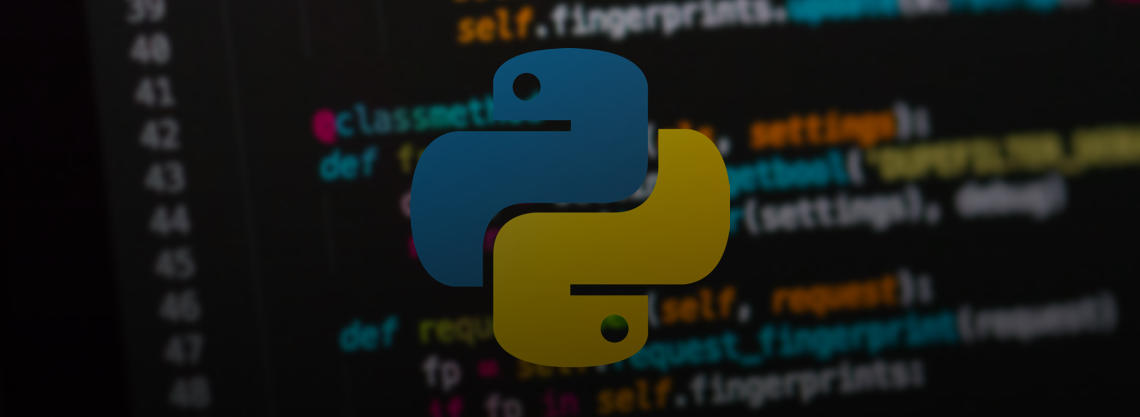For years, Python has been among the most in-demand programming languages, and its popularity is expected to continue skyrocketing in 2022. That is especially true when it comes to choosing technology for back-end development.
A technology selection process is not an easy one. It requires skill and planning to decide what the tech stack for a software development project should include – admittedly, it is an art that needs to be perfected to a science. Besides, there are inevitably a number of factors that can complicate the whole selection process. One of the most significant challenges is associated with the well-known fact that there are no better or worse programming languages – each comes with its own advantages and disadvantages.
Therefore, in this article, we are going to get to the root of the matter, figure out why choosing the right back-end technology is so important, and try to test and verify the hypothesis that despite unique developers’ preferences or apps’ specific features, Python actually embodies the near-unattainable ideal of the perfect universal language for your project’s back end.
Why is it important to choose the right back-end technology for your app?
For starters, what is back-end development? While the primary subject of our discussion is web app back-end development, it makes sense to regard it as part of the front-end vs. back-end juxtaposition.
It is common knowledge that modern web applications are constructed from two parts: front end and back end. Front-end development is anything and everything that has to do with the user interface (what is displayed on users’ screens) and experience. So, front-end developers write code to build user interfaces. Traditionally, they are being built with HTML, CSS, and JavaScript. Yet, everything is constantly changing in the realm of IT, and as we’ve noted in one of our previous articles, one should expect React.js to be the most wanted front-end technology in 2022.
Back-end technologies is another major part of every tech stack. The back-end of an application is where all the magic happens. It remains invisible to users but is still responsible for providing a backbone to the whole app and powering the client side.
It is a usual practice to draw a distinction between the client side and the server side, associating them with the front and back end accordingly. That’s partially true, as Client refers to an internet browser on the user’s device where an app runs, while Server stands for the machine where the app is hosted and that Client communicates with to carry out the user’s commands.
Let’s, for example, take a look at how the client side and the server side work in WordPress:
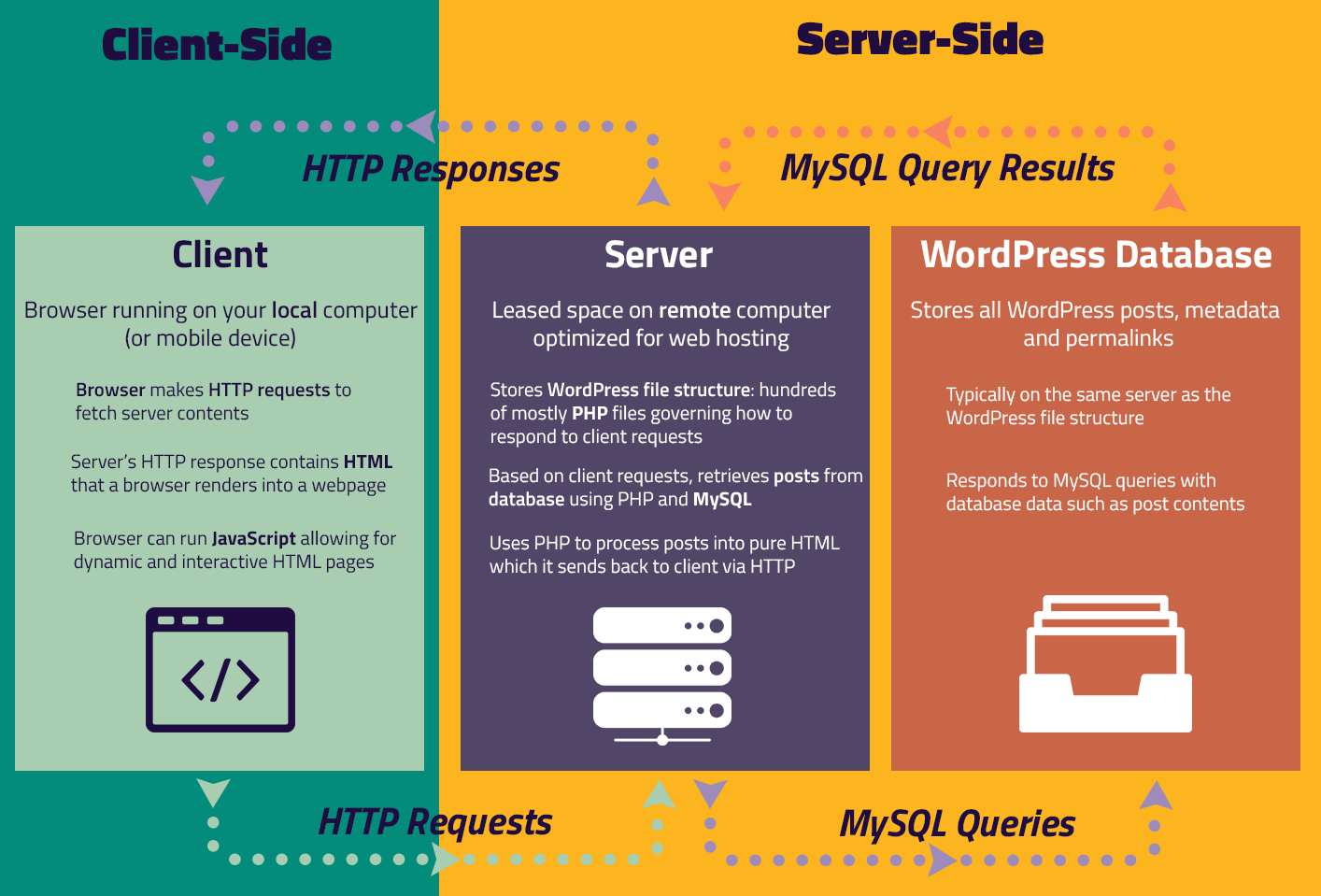
This way, it’s better to say that the back end is everything that happens on the server side, but we would advise leaving a side note that data storage, retrieval, and manipulation can still be subject to client-side rendering, which, however, doesn’t make them front-end operations.
A proper tech stack must include both front-end and back-end technologies that should work in harmony to help you turn your business ideas into reality and drive your application’s success. Choosing the right back-end technologies is crucial for a number of reasons.
First, the app back-end is its heart that must work flawlessly, so one has to be positive that the selected stack can provide that. Second, back-end is not only a programming language like Python, Ruby, or PHP, it is also the supporting frameworks, libraries, and other technologies that help build a quality software product, so one should invest time and effort into researching which back-end technologies can be blended in one project without making much trouble. Last but not least, different technologies are designed to be used and unveil opportunities hidden in various problem domains. Thus, Python is not only one of the most common backend languages but also the one that can easily meet all three criteria. Let’s go into more detail about how it actually manages to do so.
Reasons to use Python for developing your product’s backend
According to Statista, in early 2020, Python was among the top five most widely used programming languages around the world, only yielding the palm to JavaScript, HTML/CSS, and SQL. Popularity is a reasonably good reference point when it comes to choosing the best technology for app development and, in particular, for designing the app’s back-end. And it rarely comes out of thin air – there is the positive experience of thousands or even millions of people who remained satisfied upon using the language. At the same time, the positivity of the experience is neither groundless nor accidental – it is the result of people’s making good use of what Python has to offer.
In 2022, if you’re in doubt about what to choose for the backend development, our advice is to give careful consideration to Python! It's safe and fast, can be applied to complex Machine Learning projects as well as to simple ones that are easily implemented with the help of the Django framework. The possibilities are immense, the present use cases form an endless variety of successful projects, and all this is powered by the five key benefits of Python that we are about to look into.
1. Python is relatively easy to learn.
It is not without reason that Python has been added to most school teaching curriculums, surpassing even Java that had been, until recently, the most common introductory teaching language. It has primarily happened because Python allows students to start coding quickly and learn programming concepts seamlessly by designing programs that accomplish the set tasks. Thus, it won’t take much time to write one’s first Python program and run it.
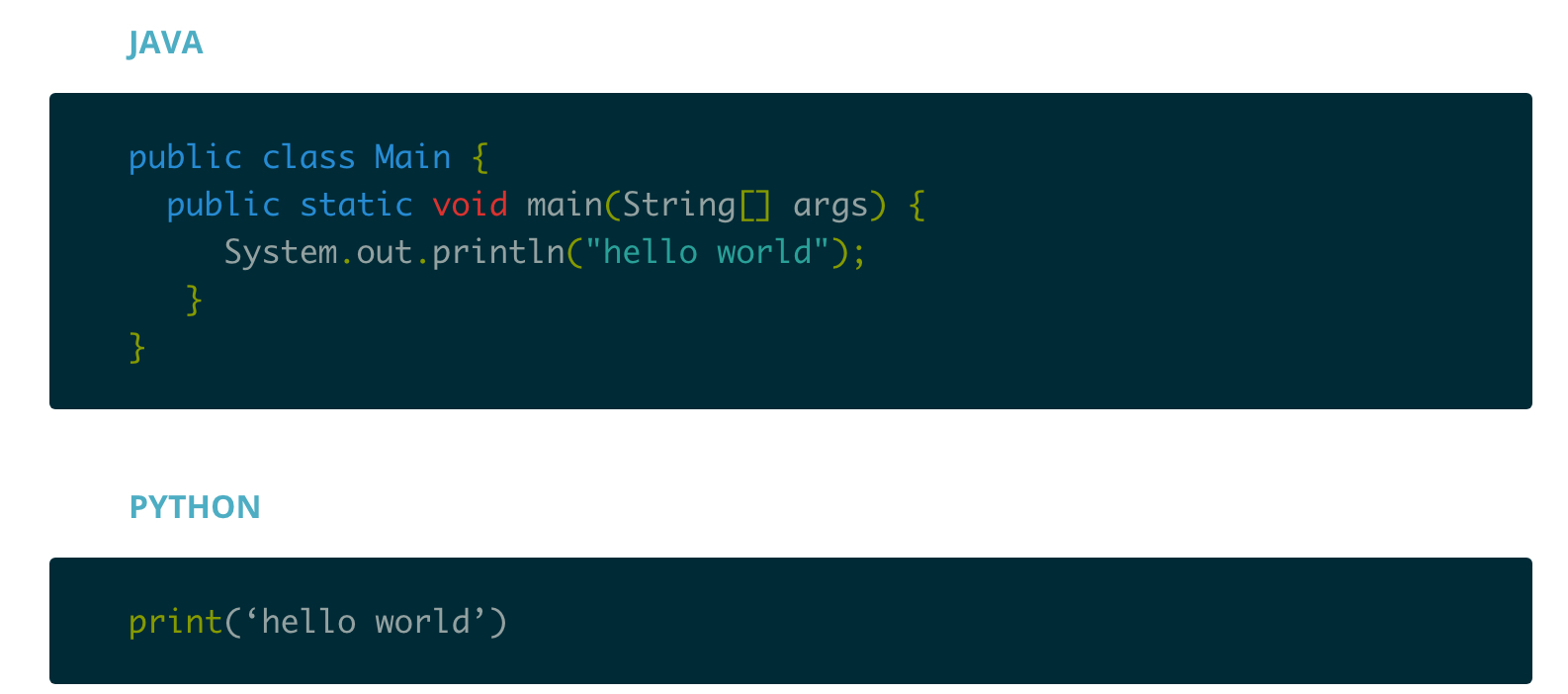
Besides, the Python basics are believed to be easy to pick up, especially if you have experience with other programming languages. It has a relatively low barrier to entry. So, everyone can learn by actually building and creating projects. Beginners already have everything for writing simple programs and scripts.
How is it a reason to choose Python for your project’s back-end development, you may wonder? Mostly, it is because the lower the barrier to entry, the more young professionals venture into learning the technology. Moreover, the fact that Python, year by year, tops numerous rankings only discourages newcomers from quitting. Nobody wants to learn a dying language, and Python is definitely far from dying. As a result, there are more skillful programmers on the job market for you to choose from.
2. Mature frameworks and development tools.
Not only is Python per se a mature and versatile language, but also there are great development tools that can be used in pair with it to boost your productivity and improve the quality of your app.
There doesn’t seem to be an aspect of web development that Python hasn’t proved to be a substantial part of. It just fits anywhere. In no small part, it is due to frameworks, libraries, and other tools that make the Python developer’s life better.
In Python, all installations are managed by the pip package installer. No matter if the packages to be installed and upgraded are from the Python Package Index or other indexes, pip consistently proves to be fast and reliable. It is easy to set up and use, so developers won’t have a hard time figuring out how to work with it.
Also, while on the subject of Python-based technologies, we cannot but mention frameworks. Django and Flask are the most widely known Python web development frameworks that are both, though at different levels, add efficiency to the development process. The latter is a micro-framework that accelerates the development of simple web applications. The former is a full-stack web framework that comes with a bunch of pre-built functionality contributing to the framework’s well-deserved popularity. Django improves code clarity and maintainability, boosts performance, and increases the ease of development. The idea behind Django is to help software engineers create code that can be passed from one person to another without facing the risk of misinterpretation, as there will be basically only one suitable way of problem-solving.
In order to successfully deal with test automation when working on a Python project, one will need only one framework, which is a Python-based automation framework called Robot Framework. It is a generic yet mature solution that helps create easy-to-read tests.
There are also a few powerful web development frameworks, such as Pyramid, Web2Py, or CherryPy, that can also come in handy.
Of course, there is a lot to further explore in terms of technologies supporting back-end development with Python. However, instead of running through all of them, we would like to focus on the ecosystem that makes Python perfect for data science.
There is a whole group of packages tailor-made for specific data science jobs. Pandas, Matplotlib, StatsModels, NumPy, SciPy, and Scikit-Learn are just several software packages that are well-known in the data science community nowadays. As time goes, Python is getting better equipped to address the challenges of data science – the libraries are growing and maturing, which allows finding solutions to problems that not so long ago could not be resolved by means of Python.
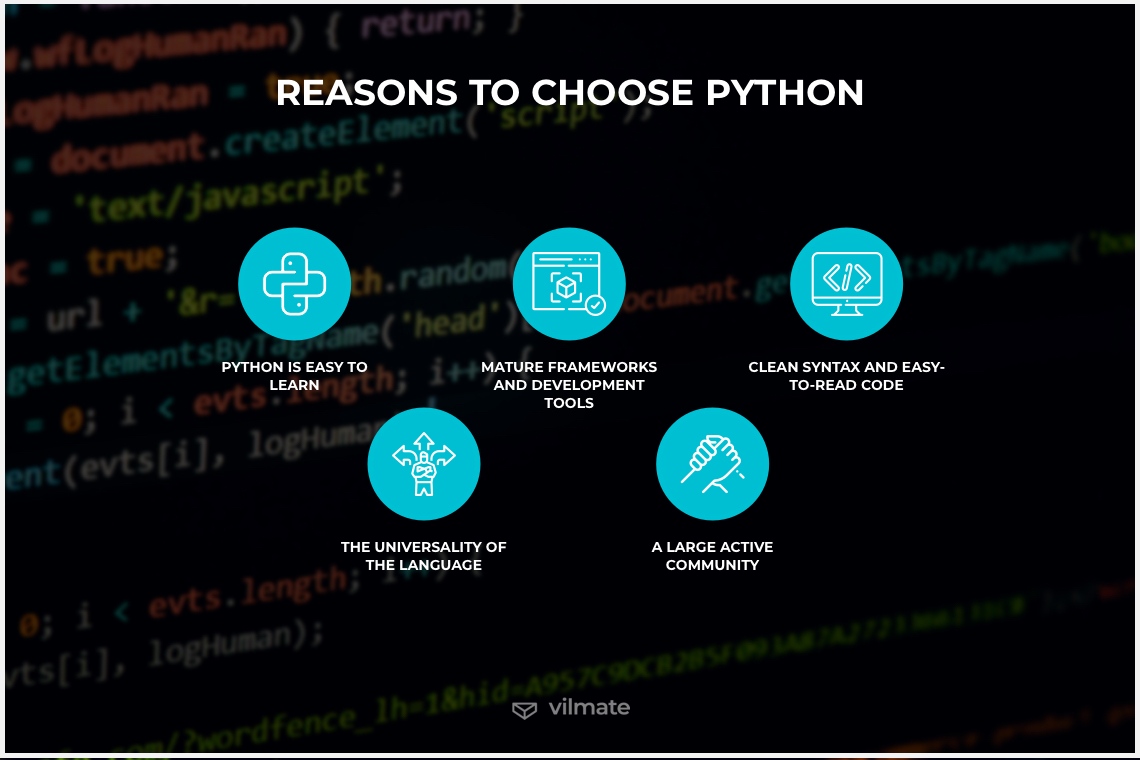
3. Сlean syntax and easy-to-read code.
Easy to write, easy to read – that’s all about Python. It is substantially less verbose than other programming languages and very readable. Python’s English-like syntax was designed to be easy to decipher.
It also requires fewer lines of code to achieve a needed result compared to such languages as, for instance, Java. Cutting down all the low-level tasks and providing high-level abstractions, Python remains concise enough to facilitate the programming and allow developers to perform nearly any tasks.
In the context of software development, syntax basically means valid code that allows running programs without return errors. And specific languages expect very specific syntax, which makes it very important in programming. The Python syntax’s inherent clarity and simplicity are what lets it stand out from the rest. “What you see is what you get.”
Python is a structured programming language that is highly readable thanks largely to the syntax consistency. The uniform and consistent appearance make Python code easier to understand and therefore maintain. As a result, code review takes less time, and developers are in a position to maintain and expand their code base by more easily navigating the code written by them or by other developers.
Besides, due to its syntax, Python combines well with React, the JS library, and the most trendy front-end technology today.
4. Python is a universal language.
The IT sector is a dynamic one, and it will be wrong to assert that no other programming language will come to take Python’s place in the future. However, it’s safe enough to claim for now that its popularity among coders hangs largely on the language’s simplicity and thus universality.
Python’s use in web development, data processing, scripting, and desktop app development is already reason enough to say that Python is in the safe zone thus far. Yet, there are many other less ordinary use cases for it:
-
Data science apps - Python is dominating in data science now. Data science is a cross-disciplinary phenomenon that exists at the intersection of math and statistics, specific domain expertise, and hacking. And the full-fledged nature of Python has made it suitable for completing these tasks. Python as a programming language has already proven to be a powerful tool for data-intensive and computational science. Accordingly, Python's data science stack–libraries keep growing in number, complexity, and effectiveness.
-
Voice and face recognition - Python is great for machine learning. ML has recently revolutionized the app development industry, and Python has turned out to be an excellent back-end language for such an area of ML as voice and face recognition. Python’s extensive set of libraries and frameworks can be extremely useful for writing face & voice recognition algorithms – they allow building reliable and straightforward systems that do the job superbly.
-
Image processing - Chances are you’ve heard that in 2019, scientists used a new algorithm to take a photo of a black hole. Do you know, however, that the now-famous picture was taken using a lot of Python libraries? Each of the researchers on the four separate imaging teams at the same time was running the image processing individually on their computer. So, Python’s abilities to manipulate images are already immense, but the potential is even higher.
-
3D modeling - Due to its increasing scripting capabilities, Python also enables modeling in a 3D space. Using Python, one can produce code that generates complex geometric forms in 3D, reactive to changes in input parameters and attractor geometries. These same capabilities are also the reason why Python is used today in game development. 3D modeling packages that empower Python to do such things include FreeCAD, Blender, Maya, Rhinoceros, and more.
-
Cybersecurity - Another important use case of Python in 2022 is for cybersecurity. Python scripts are being extensively used to develop and test security tools. Besides, it is per se an excellent programming language for penetration testing, digital forensic, and cybersecurity applications. Malware analysis, network monitoring, web scrapping, and port scanning are only a few examples of what security-related tasks can be accomplished by means of Python.
5. A large active community around Python.
The Python community is one of the reasons why this language is the right choice for your app’s back-up. The community of Python users and contributors had grown significantly since its public release in 1991. On the one hand, this is a good thing as the more highly involved developers there are, the more likely it is that you will quickly find solutions to encountered coding problems.
On the other hand, the rapidly growing user base has given rise to the problem of managing change in the language. At first, the open nature of Python's development was a deciding factor in Python's success. A community of core developers would discuss the pros and cons of the thing and then – via public debate and under Guido van Rossum’s (creator of Python) supervision – draw a conclusion. So, basically, Guido officially had the last word on any new language feature. Yet, not so long ago, he stepped down from his leadership role, and the steering council model was chosen as a new way of implementing change.
This transformation of the governance system has been welcomed by the wide core developer community and has proved to work out excellent so far. As Python extends its reach and the more surprising new uses for the language are discovered, the more developers wish to contribute and use it, and the generally better Python becomes.
Conclusion
Regardless of what area you work in, if in 2022 you get to choose a programming language for your project, you cannot go wrong selecting Python for back end.
Python is recognized as one of the best programming languages for startups as it allows developing applications that are clear and simple. At the same time, it is flexible and easy to scale, which means it always leaves room for maneuver, such as quickly getting from a prototype, an MVP, or just a small project to a full-fledged, complex app. Python is a robust back-end programming language used and trusted by many renowned companies, ensuring efficiency, security, scalability, and most of the qualitative parameters applicable to modern apps.
If you are still in doubt whether Python is a perfect choice in your case, let’s get in touch and discuss your project! We are an experienced software development company whose mission is to help businesses establish a web presence and assist them in pursuing their goals in the digital world. Contact us and let us help you decide!

© 2022, Vilmate LLC

